Rajendra B. Aklekar's Blog, page 3
April 22, 2017
FW Stevens' great grand daughter in Mumbai
Rajendra B. Aklekar
Absolute honour to co-host Diana Robertson and her husband Kevin, the fourth generation descendants of the nineteenth century iconic architect FW Stevens, along with Anita Rane-kothare, head of department of Ancient Indian Culture, St Xavier's College, in Mumbai. It was Kothare who got in touch with her and connected her with the city. It was Diana's very first visit to Mumbai and she was very sentimental to see that Stevens is so much respected and remembered in Mumbai even today. (Read her visit details HERE)
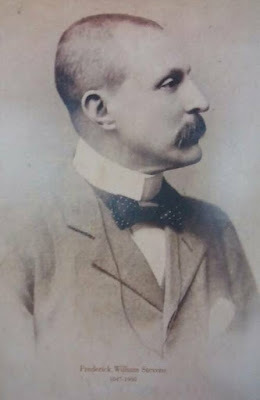 Frederick William Stevens (FW Stevens)The event was jointly conducted with the co-operation of Central Railway chief PRO Narendra Patil and his team. Also thanks to Pheroza Godrej, Bharat Gothoskar of Khaki Tours.
Frederick William Stevens (FW Stevens)The event was jointly conducted with the co-operation of Central Railway chief PRO Narendra Patil and his team. Also thanks to Pheroza Godrej, Bharat Gothoskar of Khaki Tours.
It was a privilege to receive a memento at the hands of Pheroza Godrej at the event.
For the uninitiated FW Stevens or Frederick William Stevens is the architect of Victoria Terminus- today Mumbai CST, a UNESCO-listed World Heritage site, the Mumbai Municipal Head Office, the Western Railway Churchgate Head Office (formerly Bombay Baroda and Central India Office), the Sailors Home, what is today the Maharashtra Police Headquarters and many more in Mumbai.
Stevens received various honours. He was made a Companion of the Order of the Indian Empire "for services rendered in connection with public buildings in Bombay," and gained medals for his designs in exhibitions held in Bombay in 1872 and 1879, as well as becoming a Fellow of the Royal Institute of British Architects.
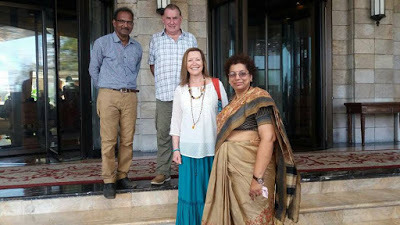 Receiving FW Stevens' descendant Diana Robertson and
Receiving FW Stevens' descendant Diana Robertson and
Kevin at the Taj, alongwith Anita Rane-KothareHe was only 52 when he died of malaria at his home in the Malabar Hills in 1900, and was buried in Sewri Christian Cemetery, where his grave carries the inscription, "In loving memory of Frederick William Stevens, born May 11th 1847, died March 3rd 1900." Diana also broke down at the cemetary during the visit on April 20, 2017. A few photographs.
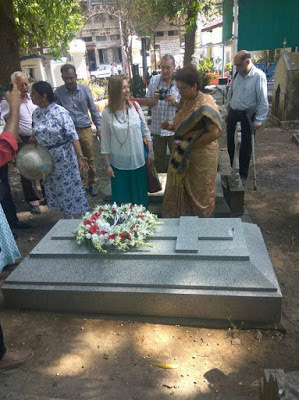 Diana at the Sewri Christian Cemetery, Mumbai
Diana at the Sewri Christian Cemetery, Mumbai
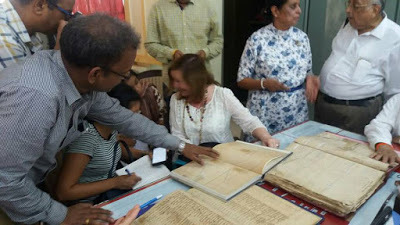 The old burial details and purchase records
The old burial details and purchase records
at the Sewri Christian Cemetery, Mumbai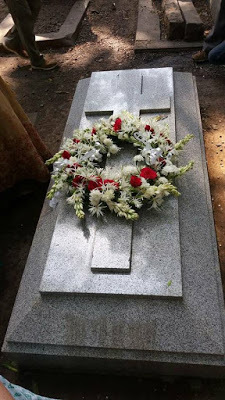 FW Stevens grave at Sewri Christian Cemetery, Mumbai
FW Stevens grave at Sewri Christian Cemetery, Mumbai
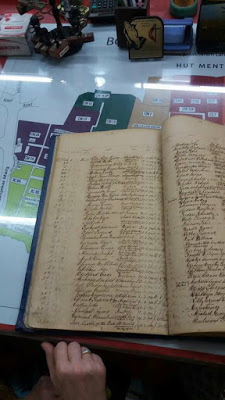 The old records at Sewri Christian Cemetery, Mumbai
The old records at Sewri Christian Cemetery, Mumbai
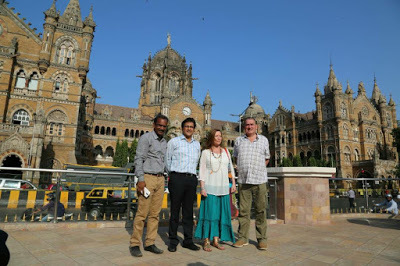 Moment of Pride: In front of the building with the creator's descendants
Moment of Pride: In front of the building with the creator's descendants
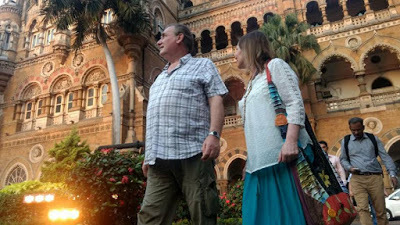 In front of Mumbai CST, formerly Victoria Terminus
In front of Mumbai CST, formerly Victoria Terminus
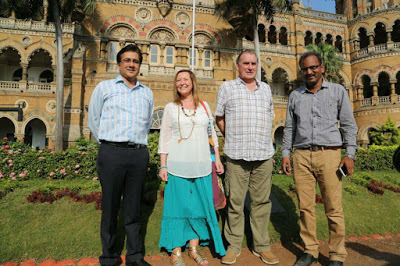 In front of Mumbai CST, formerly Victoria Terminus
In front of Mumbai CST, formerly Victoria Terminus
 On the second floor, below the dome of the iconic
On the second floor, below the dome of the iconic
Mumbai CST, formerly Victoria Terminus building
 Privileged to receive a memento at the hands of Pheroza Godrej
Privileged to receive a memento at the hands of Pheroza Godrej
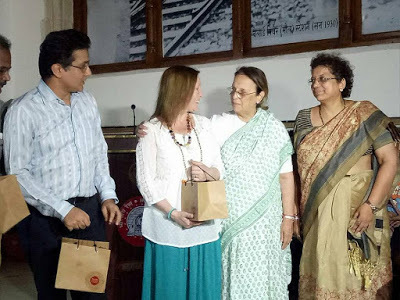
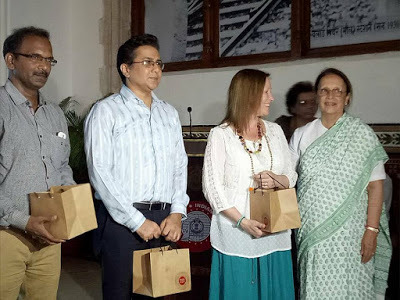
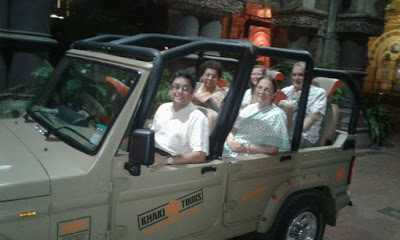

Absolute honour to co-host Diana Robertson and her husband Kevin, the fourth generation descendants of the nineteenth century iconic architect FW Stevens, along with Anita Rane-kothare, head of department of Ancient Indian Culture, St Xavier's College, in Mumbai. It was Kothare who got in touch with her and connected her with the city. It was Diana's very first visit to Mumbai and she was very sentimental to see that Stevens is so much respected and remembered in Mumbai even today. (Read her visit details HERE)
 Frederick William Stevens (FW Stevens)The event was jointly conducted with the co-operation of Central Railway chief PRO Narendra Patil and his team. Also thanks to Pheroza Godrej, Bharat Gothoskar of Khaki Tours.
Frederick William Stevens (FW Stevens)The event was jointly conducted with the co-operation of Central Railway chief PRO Narendra Patil and his team. Also thanks to Pheroza Godrej, Bharat Gothoskar of Khaki Tours.It was a privilege to receive a memento at the hands of Pheroza Godrej at the event.
For the uninitiated FW Stevens or Frederick William Stevens is the architect of Victoria Terminus- today Mumbai CST, a UNESCO-listed World Heritage site, the Mumbai Municipal Head Office, the Western Railway Churchgate Head Office (formerly Bombay Baroda and Central India Office), the Sailors Home, what is today the Maharashtra Police Headquarters and many more in Mumbai.
Stevens received various honours. He was made a Companion of the Order of the Indian Empire "for services rendered in connection with public buildings in Bombay," and gained medals for his designs in exhibitions held in Bombay in 1872 and 1879, as well as becoming a Fellow of the Royal Institute of British Architects.
 Receiving FW Stevens' descendant Diana Robertson and
Receiving FW Stevens' descendant Diana Robertson and Kevin at the Taj, alongwith Anita Rane-KothareHe was only 52 when he died of malaria at his home in the Malabar Hills in 1900, and was buried in Sewri Christian Cemetery, where his grave carries the inscription, "In loving memory of Frederick William Stevens, born May 11th 1847, died March 3rd 1900." Diana also broke down at the cemetary during the visit on April 20, 2017. A few photographs.
 Diana at the Sewri Christian Cemetery, Mumbai
Diana at the Sewri Christian Cemetery, Mumbai
 The old burial details and purchase records
The old burial details and purchase records at the Sewri Christian Cemetery, Mumbai
 FW Stevens grave at Sewri Christian Cemetery, Mumbai
FW Stevens grave at Sewri Christian Cemetery, Mumbai
 The old records at Sewri Christian Cemetery, Mumbai
The old records at Sewri Christian Cemetery, Mumbai
 Moment of Pride: In front of the building with the creator's descendants
Moment of Pride: In front of the building with the creator's descendants In front of Mumbai CST, formerly Victoria Terminus
In front of Mumbai CST, formerly Victoria Terminus In front of Mumbai CST, formerly Victoria Terminus
In front of Mumbai CST, formerly Victoria Terminus
 On the second floor, below the dome of the iconic
On the second floor, below the dome of the iconicMumbai CST, formerly Victoria Terminus building
 Privileged to receive a memento at the hands of Pheroza Godrej
Privileged to receive a memento at the hands of Pheroza Godrej




Published on April 22, 2017 08:21
January 5, 2017
Century-old signal cabin along India's first railway line pulled down
A 100-year-old signal cabin lost its life to make way for the landing of a new pedestrian bridge at Kurla suburban railway station. This had been a part of India's first railway company, the Great Indian Peninsula Railway Company.
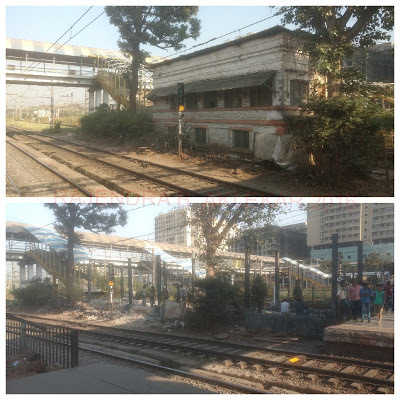



Published on January 05, 2017 03:47
1st Day tickets of Ram Mandir railway station in Mumbai
First day tickets issued from Mumbai's newest suburban railway station Ram Mandir collected by friend Jigar Desai. The station on Western Railway Mumbai division was formally opened on December 22, 2016.
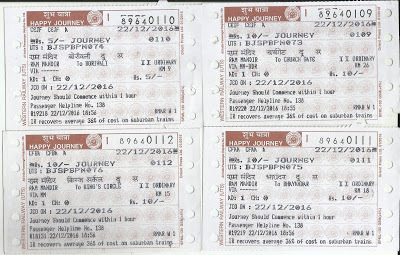



Published on January 05, 2017 03:00
December 11, 2016
Fourth imprint -- Halt Station India
Yes! Excited to announce the 4th imprint of my successful book on the story of India's 1st railway. Thank u, all. For those who still haven't bought it, here are the details: To place an order..
Please call for home delivery--
 Mumbai number- 02223524655, 02223511381. Monday to Friday 9.30pm to 5.30pm. Saturday 9.30pm to 2.00pm, Sunday closed.
Mumbai number- 02223524655, 02223511381. Monday to Friday 9.30pm to 5.30pm. Saturday 9.30pm to 2.00pm, Sunday closed.
Email at kgminternational @ gmail.com
The book is also available online on Flipkart/Amazon and also at book stores
To buy in India
On FLIPKART, click HERE
On AMAZON INDIA, click HERE
To buy locally in the UK
On AMAZON UK, click HERE
For the US and other countries
On AMAZON.COM, click HERE
Please call for home delivery--
 Mumbai number- 02223524655, 02223511381. Monday to Friday 9.30pm to 5.30pm. Saturday 9.30pm to 2.00pm, Sunday closed.
Mumbai number- 02223524655, 02223511381. Monday to Friday 9.30pm to 5.30pm. Saturday 9.30pm to 2.00pm, Sunday closed. Email at kgminternational @ gmail.com
The book is also available online on Flipkart/Amazon and also at book stores
To buy in India
On FLIPKART, click HERE
On AMAZON INDIA, click HERE
To buy locally in the UK
On AMAZON UK, click HERE
For the US and other countries
On AMAZON.COM, click HERE

Published on December 11, 2016 06:16
November 25, 2016
Mumbai suburban railway goes religious!
Rajendra B. Aklekar
So with the Maharashtra government now deciding to name the proposed Oshiwara station between Jogeshwari and Goregaon on Churchgate-Virar section of Mumbai division of Western Railway as Ram Mandir, Mumbai suburban railway, the city’s lifeline, has now become a completely secular railway and come a full circle.
Controversies apart, and I do not have any political views, but lightly speaking it now has a Churchgate, a Masjid Bunder, a Guru Tegh Bahadur Nagar and now a Ram Mandir. :)
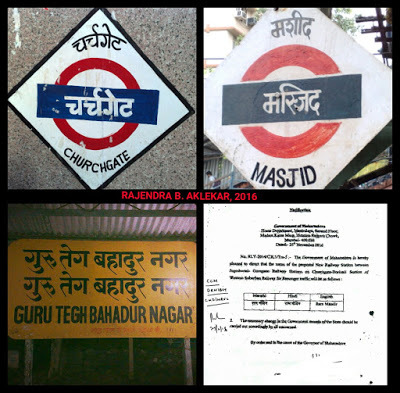 Let’s look at their brief history.
Let’s look at their brief history. Churchgate: Mumbai (today’s south Mumbai) was a walled, fortified city with moats. The fortification had three main gates. And one of the gates was an entry to the St. Thomas Church, today’s St Thomas Cathedral. The road was named Churchgate as the road from led to this church. This gate, which roughly stood where today’s Flora Fountain stands, was demolished in 1860. The railway station that came up near the gate’s proximity on the Bombay, Baroda and Central India line (today’s Western Railway) was named Churchgate.
Masjid Bunder: Named after an old jetty which was near a mosque (masjid), this station on Central Railway Mumbai comes just after the iconic Mumbai CST. Records suggest the station probably got its name from the 200-year old Gate of Mercy Synagogue, called Juni Masjid, along Samuel Street in Mandvi in the east of the station, one of Mumbai’s oldest synagogues. Another one Saat-Taad mosque, simply translated “seven palm trees” is located just next to the station today hidden amid a maze of warehouses and wholesale dealers with a narrow entrance today
.
Guru Tegh Bahadur Nagar: Originally called Koliwada, this station on the harbour line of Central Railway Mumbai was renamed Guru Tegh Bahadur Nagar after the ninth of the ten Gurus of Sikhism in July 1979.
Ram Mandir: The proposed Oshiwara station had been under construction for quite some time. Political parties demanded that the station be renamed as Ram Mandir station in recognition of a popular temple in the area. The road that leads to the station is called Ram Mandir Road. Today, the Maharashtra government approved the proposal.

Published on November 25, 2016 07:38
November 11, 2016
F. W Stevens birthday celebrated in Mumbai
Rajendra B. Aklekar, Mumbai.
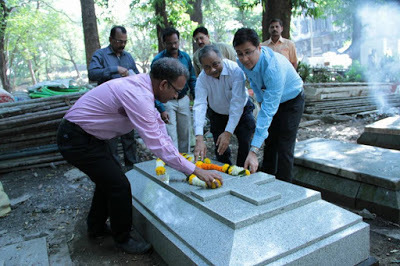 Started the day (November 11, 2016) by paying homage to Frederick William Stevens on his 169th birth anniversary at his grave in the Sewri Cemetery along with Central Railway delegation. '
Started the day (November 11, 2016) by paying homage to Frederick William Stevens on his 169th birth anniversary at his grave in the Sewri Cemetery along with Central Railway delegation. 'The architect has not just designed the wonderful Victoria Terminus -- Mumbai CST heritage building, but also the Mumbai Municipal Corporation head office, Churchgate heritage building, what is now the Maharashtra Police head office building opposite Regal Cinema, the artistic water fountain opposite GPO and much more, all major icons of South Mumbai.
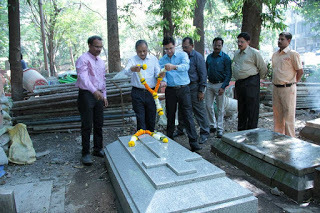 A salute and a happy birthday.
A salute and a happy birthday.  An official event was also been organised on the occasion this evening in the prestigious dining hall of Mumbai CST station.
An official event was also been organised on the occasion this evening in the prestigious dining hall of Mumbai CST station.
Published on November 11, 2016 04:09
October 18, 2016
Kalka Simla Rail Bus 1945, India
Published on October 18, 2016 02:06
Once upon a time: Byculla — station with a history as old as Railways
From the Indian Express Mumbai Published:October 9, 2016 3:12 amThe station itself is a listed heritage structure according to BMC recordsONE of the busiest stations on Central Railway, the Byculla station, is actually more than 125 years old. Suddenly in the news over reports that it could see a remodelling in the coming years to accommodate more railway lines, the station, which opens onto the busy JJ Road area, has tremendous significance in history. According to records, construction of the station started in 1887 and was completed in 1891.When the first railway line became operational in India, with a train leaving Bombay’s Victoria Terminus at Bori Bunder on April 16, 1853 at 15.30 hrs for Thana (today’s Thane), one of its halts was at the very area where the Byculla station would eventually be built. Railway historian Rajendra B Aklekar says, “Byculla has an important place in the history of Indian railways and was one of the stations along India’s first railway route. It was the place from where trials of the first passenger steam locomotive were held before trains began to run in 1853, between Byculla and Parel.”In the British era, prior to the 1880s, it was Byculla that had more prominence on a daily basis than the Bori Bunder station owing to its proximity to the horse stables. “Byculla is also the place where the Bombay Governor’s wife Lady Falkland took her first ride on the train in 1853,” Aklekar adds. The original Byculla station structure was not located exactly where it is today — it was a bit further south, opposite Mankeshwar Temple. But the wide porches, poles and arches of the present-day station are dipped in heritage — one ticket window bears the logo of the old railway service before it was renamed.The station itself is a listed heritage structure according to BMC records. Its arched decorative roof is somewhat hidden behind the chaos immediately outside both exits, and the general grubbiness dims the more aesthetic aspects of the structure. According to records, the station’s design had to be revised by the railway’s senior officials in London, to shave off some costs. By the time the building was finally constructed, the Victoria Terminus building was simultaneously being completed. The contractor for both structures was the same Parsi firm, Berjoorjee Rustomjee Mistri and Co.


Published on October 18, 2016 02:01
October 17, 2016
Old-style Mumbai local train when it was new
The old-fashioned Mumbai local train when it was new...and that has become unwanted now... 1950s.Photo Courtesy: PhotoDivision, India.
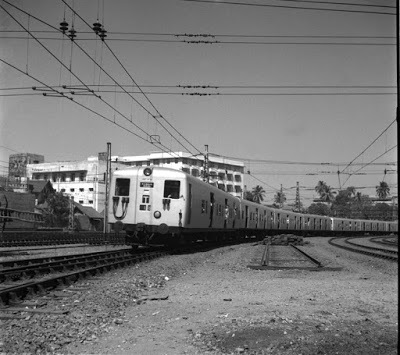



Published on October 17, 2016 00:23
October 5, 2016
A steam loco being built in India. November 1954
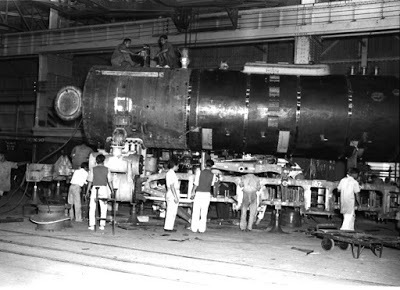
An engine under erection. Locomotive Works. Chittaranjan. India. November 1954. Photo Courtesy: Photo Division, India.

Published on October 05, 2016 07:02





